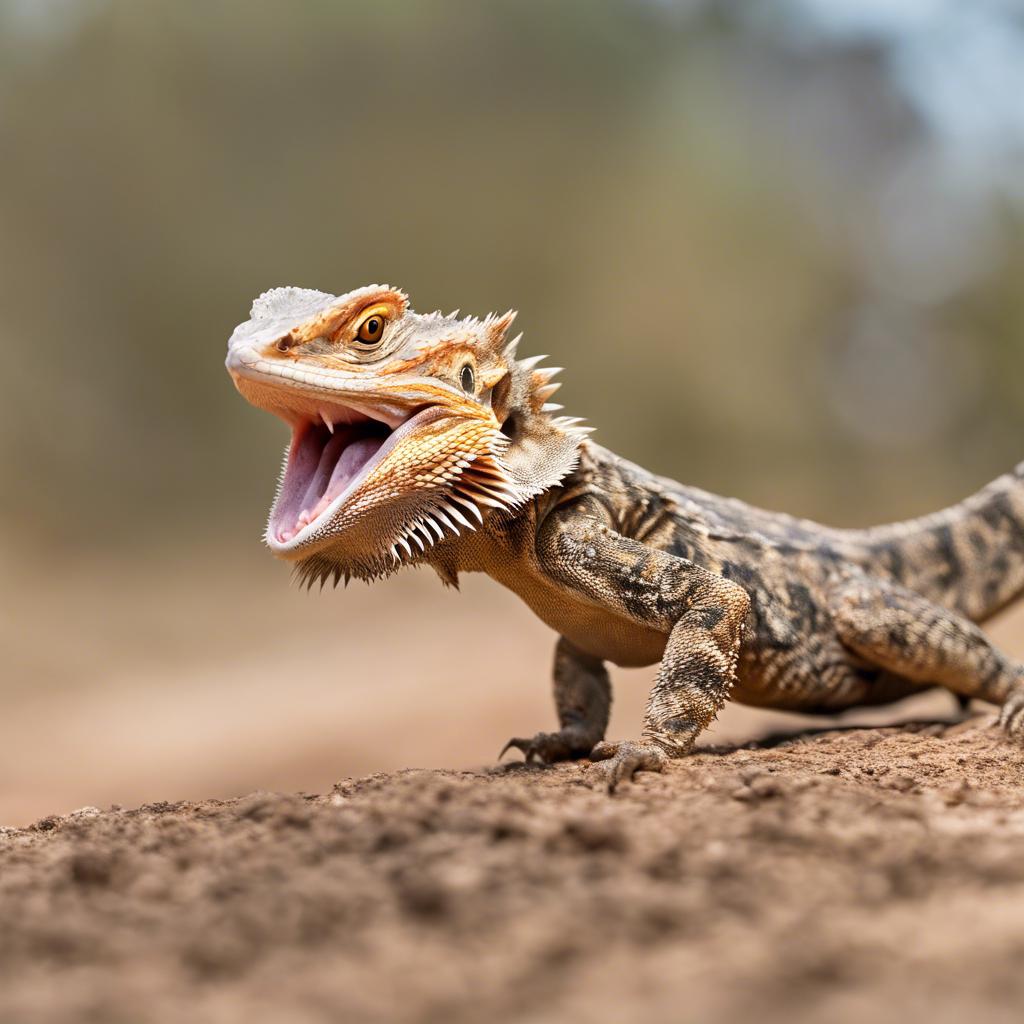Bearded dragons, scientifically known as Pogona, are a type of lizard native to Australia. They are popular pets due to their docile nature and unique appearance. Bearded dragons get their name from the spiky beard-like scales on their throats, which they can puff up when they feel threatened or excited. These reptiles have become increasingly popular as pets because of their friendly demeanor and relatively low maintenance requirements.
One of the reasons why bearded dragons make great pets is their calm and friendly nature. They are known for being docile and easy to handle, making them suitable for both experienced reptile owners and beginners. Bearded dragons are also highly adaptable and can thrive in a variety of environments, including both indoor and outdoor enclosures. Additionally, they have a long lifespan, with some individuals living up to 10-15 years with proper care.
Key Takeaways
- Bearded dragons are popular pets that require proper care and attention.
- Understanding their anatomy and behavior is crucial for their well-being.
- Bearded dragons are native to arid regions of Australia and require a specific habitat.
- Exercise is important for bearded dragons, and jumping is a natural behavior for them.
- Factors such as age, size, and health can affect a bearded dragon's jumping ability.
The Anatomy of Bearded Dragons
Bearded dragons have a unique physical appearance that sets them apart from other reptiles. They have a stout body covered in rough, bumpy scales that provide protection from predators. Their most distinctive feature is the beard-like scales on their throats, which can change color depending on their mood or temperature. When they are calm, the beard is usually a pale color, but it can darken to black when they feel threatened or excited.
Another notable feature of bearded dragons is their long tail, which makes up about two-thirds of their total body length. The tail serves multiple purposes, including balance and fat storage. Bearded dragons also have sharp claws on their feet that allow them to grip onto surfaces and climb trees or rocks.
The anatomy of bearded dragons plays a significant role in their behavior. For example, their beard serves as a visual communication tool. When a bearded dragon puffs up its beard, it is often a sign of aggression or territoriality. On the other hand, a relaxed and flattened beard indicates a calm and contented state. Understanding their anatomy can help owners interpret their behavior and provide appropriate care.
Understanding Bearded Dragon Behavior
Bearded dragons exhibit various behaviors that can provide insight into their mood and well-being. One common behavior is head bobbing, which is often seen in males during mating season or when they are trying to establish dominance. Head bobbing can also be a sign of stress or discomfort, so it's essential to observe other body language cues to determine the underlying cause.
Another behavior to watch for is arm waving, where a bearded dragon raises one of its front legs and waves it in a slow, deliberate motion. This behavior is often seen when they are trying to communicate submission or appeasement to another bearded dragon or their owner. It can also be a sign of stress or discomfort, so it's crucial to assess the overall context and body language.
Understanding bearded dragon body language is crucial for their well-being. For example, if a bearded dragon flattens its body and opens its mouth wide, it may be a sign of aggression or feeling threatened. Conversely, if they are basking with their body stretched out and their beard relaxed, it indicates a state of comfort and relaxation. By observing their behavior and body language, owners can better understand their needs and provide appropriate care.
The Natural Habitat of Bearded Dragons
Bearded dragons are native to the arid regions of Australia, primarily found in the central and western parts of the country. They inhabit a variety of habitats, including deserts, woodlands, and scrublands. These environments are characterized by hot temperatures during the day and cooler temperatures at night.
In the wild, bearded dragons spend much of their time basking in the sun to regulate their body temperature. They are excellent climbers and can often be found perched on rocks or branches. Bearded dragons are also known for their ability to dig burrows, which provide shelter and protection from predators.
Understanding the natural habitat of bearded dragons is essential for providing appropriate care in captivity. Owners should strive to replicate their natural environment as closely as possible, including providing a basking spot with a heat source, UVB lighting, and a suitable substrate for digging and burrowing.
The Importance of Exercise for Bearded Dragons
Exercise is crucial for the overall health and well-being of bearded dragons. Regular physical activity helps maintain muscle tone, promotes digestion, and prevents obesity. It also provides mental stimulation and helps prevent boredom.
Bearded dragons are naturally active animals and require ample space to move around. In captivity, it's essential to provide them with an adequately sized enclosure that allows for climbing, exploring, and basking. Owners should also provide opportunities for exercise outside of the enclosure, such as supervised time in a secure outdoor area or a designated play area indoors.
The amount of exercise a bearded dragon needs can vary depending on its age and overall health. Younger dragons tend to be more active and require more exercise than older individuals. However, it's important not to overexert them, especially if they are still growing or recovering from illness or injury. Owners should observe their bearded dragon's behavior and adjust their exercise routine accordingly.
How High Can Bearded Dragons Jump?

Bearded dragons are capable of impressive jumps despite their relatively short legs. On average, they can jump up to 2-3 times their body length vertically. This means that a bearded dragon measuring 18 inches from head to tail can potentially jump up to 36-54 inches in height.
In the wild, bearded dragons use their jumping ability to escape predators or reach higher perches for basking or hunting insects. They can also use their powerful hind legs to propel themselves forward when running or chasing prey.
Factors that Affect Bearded Dragon Jumping Ability
Several factors can influence a bearded dragon's jumping ability. Age, size, and weight play a significant role in determining how high they can jump. Younger dragons tend to be more agile and have more muscle strength, allowing them to jump higher than older individuals. Similarly, smaller and lighter dragons may have an easier time jumping compared to larger and heavier ones.
The overall health and physical condition of a bearded dragon can also affect its jumping ability. If a dragon is overweight or has muscle weakness, it may struggle to jump as high as a healthy individual. Providing a balanced diet and regular exercise can help maintain optimal physical condition and improve jumping ability.
Environmental factors, such as the surface they are jumping from and the temperature, can also impact their jumping ability. A slippery or unstable surface may hinder their ability to jump effectively. Additionally, bearded dragons are ectothermic animals, meaning their body temperature is regulated by external sources. If the temperature is too cold, their muscles may not function optimally, affecting their jumping ability.
Tips for Encouraging Bearded Dragon Jumping
Encouraging jumping in bearded dragons can provide mental stimulation and physical exercise. Here are some tips for creating a safe jumping environment and encouraging this natural behavior:
1. Create a safe jumping environment: Ensure that the area where your bearded dragon will be jumping is free of hazards or sharp objects that could cause injury. Remove any fragile or valuable items that could be knocked over during the jumping session.
2. Use toys and obstacles: Place toys or obstacles in the jumping area to provide targets for your bearded dragon to jump towards. This can include branches, platforms, or even small hoops for them to jump through. Make sure these objects are stable and secure to prevent accidents.
3. Positive reinforcement techniques: Use treats or praise to reward your bearded dragon for successfully jumping. This positive reinforcement will encourage them to continue jumping and make it a fun and rewarding experience for them.
Bearded Dragon Care: Precautions to Take when Encouraging Jumping
While encouraging jumping in bearded dragons can be beneficial, it's essential to take precautions to prevent injuries or overexertion. Here are some precautions to keep in mind:
1. Provide a soft landing surface: Place a soft material, such as a towel or cushion, beneath the jumping area to provide a cushioned landing surface. This will help prevent injuries if your bearded dragon falls or lands awkwardly.
2. Monitor for signs of overexertion or exhaustion: Bearded dragons can become tired or overheated after prolonged jumping sessions. Watch for signs of fatigue, such as heavy breathing, excessive panting, or reluctance to continue jumping. If your bearded dragon shows signs of exhaustion, give them a break and provide a cool and comfortable resting area.
3. Seek veterinary care if necessary: If your bearded dragon experiences any injuries or shows signs of distress after jumping, it's important to seek veterinary care. A veterinarian with experience in reptile care can assess the situation and provide appropriate treatment.
Conclusion and Summary of Bearded Dragon Jumping Abilities
In conclusion, bearded dragons are fascinating reptiles that make great pets due to their friendly nature and unique appearance. Understanding their anatomy and behavior is crucial for providing appropriate care and ensuring their well-being. Bearded dragons have the ability to jump impressive heights, which they use in the wild for various purposes.
Factors such as age, size, weight, health, and environmental conditions can affect their jumping ability. By creating a safe jumping environment and using positive reinforcement techniques, owners can encourage this natural behavior in their bearded dragons. However, it's important to take precautions to prevent injuries or overexertion and seek veterinary care if necessary.
Overall, bearded dragons are remarkable creatures that can bring joy and companionship to their owners. By providing proper care and understanding their unique needs, owners can ensure a happy and healthy life for their bearded dragons.
If you're curious about how high bearded dragons can jump, you'll definitely want to check out this informative article on Reptile Wizard's website. It provides valuable insights into the jumping abilities of these fascinating reptiles. To learn more, click here: https://reptilewizard.com/reptile-keeping/how-high-can-bearded-dragons-jump/.
FAQs
What is a bearded dragon?
A bearded dragon is a type of lizard that is native to Australia. They are popular pets due to their docile nature and ease of care.
How high can bearded dragons jump?
Bearded dragons are not known for their jumping abilities. They are more likely to climb than jump, and can typically only jump a few inches off the ground.
What factors affect a bearded dragon's jumping ability?
The size and age of the bearded dragon can affect its jumping ability. Younger, smaller bearded dragons may be more agile and able to jump higher than older, larger ones.
Why do bearded dragons jump?
Bearded dragons may jump to escape from predators or to catch prey. However, in captivity, they are unlikely to need to jump for these reasons.
Is it safe to let my bearded dragon jump?
While bearded dragons are not known for their jumping abilities, they are generally safe to let jump short distances. However, it is important to provide a safe environment for them to do so and to supervise them while they are jumping.

